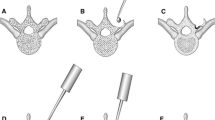Abstract
Study design
Technique note.
Objectives
To report a new method for precisely controlling the depth of percutaneous pedicle screws (PPS)—without radiation exposure to surgeons and less fluoroscopy exposure to patients than with conventional methods.
Summary of background data
PPS is widely used in minimal invasive spine surgery; the advantages include reduced muscle damage, pain, and hospital stays. However, placement of PPS demands repeated checking with fluoroscopy. Thus, radiation exposure is considerable for both surgeons and patients.
Methods
The PPS depth was determined by counting rotations of the screws. The distance between screw threads can be measured for particular screws; thus, full rotations of the PPS results in the screw advancing in the pedicle the distance between screw threads. To fully insert screws into the pedicle, the number of full rotations is equal to the number of threads in the PPS.
Results
We applied this technique in 58 patients with thoracolumbar fracture. The position and depth of the screws was checked during the operation with the C-arm and after operation by anteroposterior X-ray film or computed tomography. No additional procedures were required to correct the screws; we observed no neurological deficits or malpositioning of the screws. In the screw placement procedure, the radiation exposure for surgeons is zero, and the patient is well protected from extensive radiation exposure.
Conclusions
This method of counting rotation of screws is a safe way to precisely determine the depth of PPS in the placement procedure.
Level of evidence
IV.



Similar content being viewed by others
References
Ohba T, Ebata S, Fujita K, Sato H, Haro H (2016) Percutaneous pedicle screw placements: accuracy and rates of cranial facet joint violation using conventional fluoroscopy compared with intraoperative three-dimensional computed tomography computer navigation. Eur Spine J Off Publ Eur Spine Soc Eur Spinal Deform Soc Eur Sect Cerv Spine Res Soc 25(6):1775–1780. doi:10.1007/s00586-016-4489-1
Kim DY, Lee SH, Chung SK, Lee HY (2005) Comparison of multifidus muscle atrophy and trunk extension muscle strength: percutaneous versus open pedicle screw fixation. Spine 30(1):123–129
Bronsard N, Boli T, Challali M, de Dompsure R, Amoretti N, Padovani B, Bruneton G, Fuchs A, de Peretti F (2013) Comparison between percutaneous and traditional fixation of lumbar spine fracture: intraoperative radiation exposure levels and outcomes. Orthop Traumatol Surg Res OTSR 99(2):162–168. doi:10.1016/j.otsr.2012.12.012
Chapman TM, Blizzard DJ, Brown CR (2016) CT accuracy of percutaneous versus open pedicle screw techniques: a series of 1609 screws. Eur Spine J Off Publ Eur Spine Soc Eur Spinal Deform Soc Eur Sect Cerv Spine Res Soc 25(6):1781–1786. doi:10.1007/s00586-015-4163-z
Kwan MK, Chiu CK, Chan CY, Zamani R, Hansen-Algenstaedt N (2016) A comparison of feasibility and safety of percutaneous fluoroscopic guided thoracic pedicle screws between Europeans and Asians: is there any difference? Eur Spine J Off Publ Eur Spine Soc Eur Spinal Deform Soc Eur Sect Cerv Spine Res Soc 25(6):1745–1753. doi:10.1007/s00586-015-4150-4
O’Toole JE, Eichholz KM, Fessler RG (2009) Surgical site infection rates after minimally invasive spinal surgery. J Neurosurg Spine 11(4):471–476. doi:10.3171/2009.5.SPINE08633
Anderson DG, Sayadipour A, Shelby K, Albert TJ, Vaccaro AR, Weinstein MS (2011) Anterior interbody arthrodesis with percutaneous posterior pedicle fixation for degenerative conditions of the lumbar spine. Eur Spine J 20(8):1323–1330. doi:10.1007/s00586-011-1782-x
Kim MC, Chung HT, Cho JL, Kim DJ, Chung NS (2011) Factors affecting the accurate placement of percutaneous pedicle screws during minimally invasive transforaminal lumbar interbody fusion. Eur Spine J Off Publ Eur Spine Soc Eur Spinal Deform Soc Eur Sect Cerv Spine Res Soc 20(10):1635–1643. doi:10.1007/s00586-011-1892-5
Perisinakis K, Damilakis J, Theocharopoulos N, Papadokostakis G, Hadjipavlou A, Gourtsoyiannis N (2004) Patient exposure and associated radiation risks from fluoroscopically guided vertebroplasty or kyphoplasty. Radiology 232(3):701–707. doi:10.1148/radiol.2323031412
Schils F, Schoojans W, Struelens L (2013) The surgeon’s real dose exposure during balloon kyphoplasty procedure and evaluation of the cement delivery system: a prospective study. Eur Spine J Off Publ Eur Spine Soc Eur Spinal Deform Soc Eur Sect Cerv Spine Res Soc 22(8):1758–1764. doi:10.1007/s00586-013-2702-z
Acknowledgements
Funding was provided by National Natural Science Foundation of China (Grant No. 81201383).
Author information
Authors and Affiliations
Corresponding author
Ethics declarations
Conflict of interest
None of the authors has any potential conflict of interest.
Rights and permissions
About this article
Cite this article
Li, X., Zhang, F., Zhang, W. et al. A new method to precisely control the depth of percutaneous screws into the pedicle by counting the rotation number of the screw with low radiation exposure: technical note. Eur Spine J 26, 750–753 (2017). https://doi.org/10.1007/s00586-016-4870-0
Received:
Revised:
Accepted:
Published:
Issue Date:
DOI: https://doi.org/10.1007/s00586-016-4870-0




